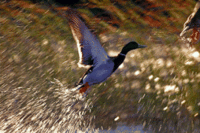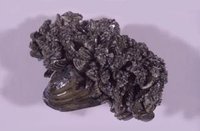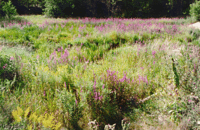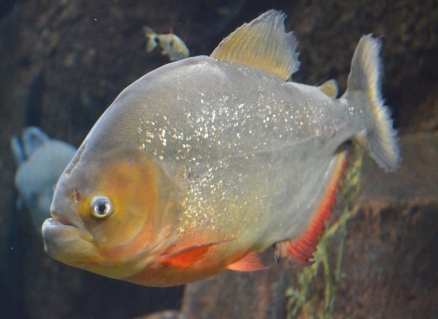Exotic species
Contents
Introduction (Source: Biodiversity Institute of Ontario (Exotic species) )
Historically, human actions have been inconsequential on the forces of nature, however, humans are now influencing the processes of the planet. The water bodies of Canada and the world are being invaded by non-native or exotic species. An exotic species is any species intentionally or accidentally transported and released by man into an environment outside its present range. These plant and animal species are considered to be among the most severe agents of habitat alteration and degradation, and they are a major cause of the continuing loss of biological diversity throughout the world.
Not all aquatic species that are introduced into new environments are successful; in fact, ecologists predict that most will fail and those that manage to survive will fail to establish reproducing colonies. An ecosystem's resistance to exotic species depends on competition between them and native species for food and habitat. The greater the diversity in an ecosystem, the more competitors an exotic species will encounter, thereby decreasing its chances of becoming established.
How Do These Species Get Introduced?
Humans have played an important role in the introduction of non-indigenous organisms into new parts of the world as the rate of dispersal of living organisms has accelerated in proportion with increased human activity around the world. Invading species can be introduced into a new ecosystem by a variety of methods.
Unintentional Release
Many species are released into new environments without the intention of creating established populations. The release of aquarium pets into the wild is common, although it is not generally the intent of the owners to establish self-sustaining populations. Common species released from aquariums are red piranha (Pygocentrus naltereri) and convict cichlids (Cichlsoma nigofasciatum).
The accidental escape of many cultivated plants from ornamental gardens is a common mechanism for the introduction of aquatic plants. Purple loosestrife (Lythrum salicaria) which now dominates many wetlands in Canada was introduced in this way.
|Fishermen dump unused bait into the water in which they are fishing, even though their bait did not come from the same water; a significant example of this is the rusty crayfish (Orconectes rusticus). Many times pathogens are released with stocked fish, or plankton are introduced in fish transport water during fish stocking programs. Other unintentional releases include the introduction of marine algae into brackish [[habitat]s] from the household disposal of seafood packaging and shells (for example, the green crab (Carcinus maenas)).
Shipping Activities
Many species are released into new environments by shipping activities. Since 1959 almost 1/3 of the exotic species in the Great Lakes have been introduced as a result of shipping activities, coinciding with the opening of the St. Lawrence Seaway.
Ocean going vessels are likely the largest vectors of biological invasion. Ships take on ballast water for stability during an ocean crossing and then dump the water before they take on cargo. More than 1 million litres of water are can be discharged by a single vessel. Biological invasions occur when ships discharge ballast water that has been taken from foreign ports. If the introduced aquatic plant or animal species is compatible with the ecological conditions of the lakes, they survive, reproduce, and disperse through the environment. This invasion mechanism has become more significant, as transoceanic crossing times have decreased. The spiny water flea (Bythotrephes cedarstroemi), and the round goby (Neogobius melanostomus) are examples of ballast water introductions into the Great Lakes.
Canals
As early as the late 1700s, canals were constructed in Northeastern North America. These canals join adjacent watersheds, allowing organisms to cross natural barriers, such as Niagara Falls. The sea lamprey (Petromyzon marinus) is a predacious, eel-like fish native to the coastal regions of the Atlantic Ocean. They were first discovered in Lake Ontario in 1830, through the Erie canal (opened in 1825) from their native habitat in the Atlantic drainage basin, they entered the rest of the Great Lakes through the Welland Canal, after it was opened in 1921. They contributed greatly to the decline of whitefish and lake trout populations in the Great Lakes.
Intentional Release
Many exotic species have been intentionally released into new water bodies. The most common example of this is fish stocking. Deliberate stocking of fish species began in the Great Lakes in the early 1870s, in order to increase the value of the fisheries (Fisheries and aquaculture). Rainbow trout and chinook salmon are two examples of fishes that were intentionally introduced to the Great Lakes.
Animal Vectors

Of all animal vectors, birds are the most important dispersal agent. Organisms can be dispersed by birds in three ways. Organisms, larvae, or eggs may be attached externally to the bird's plumage or transported within algae wrapped around to the birds feet, legs or head. Internally, live organisms may be defecated or regurgitated from a birds stomach, and released into the environment. Thirdly, organisms may be carried directly; for example, a piscivorous bird may accidentally drop a caught fish into a nearby lake.
Where Do These Species Come From?
A few examples of historical intervention
New York, U.S., 1825. The first barge came through the Erie Canal (joining Lake Erie to the Atlantic Ocean) and arrived in New York's harbor. To celebrate, the barge transported a keg of water from Lake Erie which was dumped into the harbor along with vials of water from the Nile, Thames, Seine, Ganges, and Rhine rivers. This event foreshadowed the large-scale contaminations, due to ship ballast waters, that occur today.
USA, 1870. In 1870, Spencer Baird of the US Fish Commission decided to improve the fish fauna of the United States by importing a delectable species of Eurasian carp. It was instantly successful. Carp were shipped throughout the country and started reproducing with a vengeance. However, these bottom feeding fish destroy natural habitat and are no longer considered a delicacy.
What Has Been Introduced?
Fish
In Canada, there are at least 92 species, some via intentional introductions and some accidental. Brown Trout was introduced from Germany in the 1880s into the Great Lakes, while Chinook Salmon was introduced from the Pacific Ocean in 1873.
Mollusks

There are at least 775 species of freshwater mollusk in North America, 21 of which are introduced. Impacts range from no impacts, beneficial uses, negative impacts, including human health concerns, and numerous ecological and socio-economic impacts. The zebra mussel is a well known mollusk which was introduced in 1987 and has since caused many problems.
Plants
Fifty-nine species of plant have been introduced into the Great Lakes region since the 1800s, yet only two have had substantial impacts: purple loosestrife and water millfoil.
Purple Loosestrife (Lythrum salicaria)

Purple loosestrife is a wetland plant from Eurasia. It was introduced to the East coast of North America in the 1800s. It first spread along roads and canals and was later distributed as an ornamental plant. Loosestrife readily impacts native plants by out-competing them, forming dense, impenetrable stands, that are unsuitable for cover or nesting sites. It invades marshes and lakes, replacing cattails and other wetland plants. In North America about 190,000 hectares of wetlands are lost every year with an estimated cost of 45 million dollars.
Part of the success of purple loosestrife is due to the enormous number of seeds it produces. One plant can distribute 2 million seeds annually! It is also able to resprout from roots and broken stems that fall to the ground.
There are few predators of purple loosestrife in North America. Several European insects that only attack this species are now being tested for their potential as biological control agents.
Eurasian Water Milfoil (Myriophyllum spicatum)
Water milfoil is a plant with long, flexible stems with feather-like leaves attached in whorls of four. Water milfoil grows fast, quickly choking out native plants and harming fish habitat. It grows in thick mats, interfering with boating, fishing, and swimming.
It was accidentally introduced from Europe, probably through aquarium release or ballast water release. It is spread mainly by boats and some waterbirds. The success of milfoil is due to its ability to reproduce through stem fragmentation. A single segment of stem and leaves can take root and form a new colony. The fragments cling to boats and can start new colonies when they move from one lake to another. Mechanical clearing of weed beds also creates thousands of new colonies.
Poison Hemlock (Conium maculatum)
This poisonous plant was used medicinally as a powerful narcotic. It was introduced to North America from Europe in the early 1800's. Poison hemlock is now common in on stream banks, and other damp areas throughout the Great Lakes drainage area.
Impacts of Exotic Species
Introducing exotic species is risky. Freed from their natural predators, pathogens, parasites, and competitors, exotic species have the ability to, threaten the diversity (Species diversity) and abundance of native species, and disrupt human social and economic activities. Understanding the effect of introduced species on [[ecosystem]s] is important since the global mixing of organisms has contributed to a worldwide decline in diversity, in both aquatic and terrestrial [[ecosystem]s]. In the Great Lakes about 10% of introduced species have had serious impacts. Other exotics appear to have had minor repercussions, but the impact of most species is unstudied.
Ecological Impacts
Habitats: Invaders may alter habitat by eliminating vegetation or changing water quality.
Parasites and Disease: Bacteria, viruses, and parasites introduced with exotic species represent a threat to native organisms.
Food Chain Alteration: The feeding activity of exotics can alter the availability of food resources for native species.
Loss of endemic species: Competition for food and/or space may result in the elimination of related species occupying the same niche. Predation on a native species by exotics is also a problem.
Hybridization: Exotic species may be reproduce with native populations, resulting in hybrids and the ultimate loss of the native species.
Economic Impacts
The economic impacts of invading species can be huge. Economic impacts range from the cost of chemical control agents to direct economic losses. Canada now spends $5 million a year controlling sea lamprey. The damages caused by zebra mussels covering industrial and domestic pipelines, sailing vessels, bouys, fishing gear, trap nets, and pound nets, is thought to have totalled at least $100 million since its introduction in 1987.
